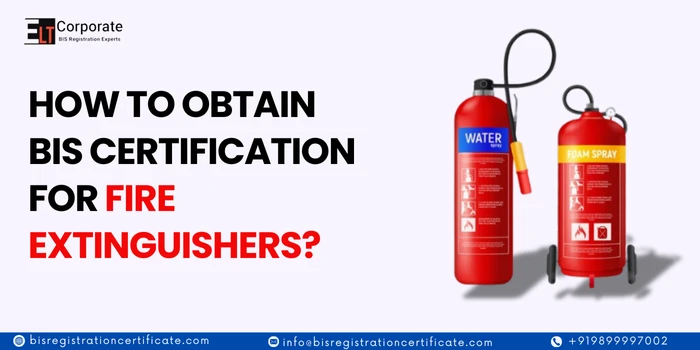Do you need help to meet safety standards for your fire extinguishers? Getting BIS certification for fire extinguishers might be the solution for you.
For fire extinguishers, Indian Standards have set the performance, quality, and reliability benchmarks. At the same time, make sure that these vital tools are prepared to save lives and property during any kind of fire emergency. Fire extinguishers are crucial in controlling fires and making them a critical component of any fire safety plan.
Therefore, in this blog, we’ll dive into the importance and process on how to obtain BIS certification for fire extinguishers.
Types Of Fire Extinguishers In India
There are multiple types of fire extinguishers available in India which are based on their shape, size, material, and the IS standards set by BIS. Listed here:
- Portable Fire Extinguishers
- Wheeled Fire Extinguishers
- Water Based Fire Extinguishers
- Dry Powder Based Fire Extinguishers
- Co2 Based Fire Extinguishers
- Water Sprinkler
Portable Fire Extinguishers
Portable fire extinguishers are lightweight, compact, and very easy to move anywhere. They are mostly seen in public places like restaurants, hotels, and trains as it is easy to use and lightweight.
In addition to this, portable fire extinguishers should not exceed 17 kg in weight as per ISI Standard IS 15683:2018.On top of that, it must be designed in a way that 2 people can use it immediately.
Wheeled Fire Extinguishers
The wheeled fire extinguishers category has larger fire extinguishers that are mounted on mini-trolleys for easy transportation to the incident site. As per IS 16018:2012, the total weight of a wheeled fire extinguisher should range between 17 kg and 450 kg, including all the equipment and accessories. Based on the fire-dousing material, wheeled fire extinguishers are further divided into the following categories:
Water-Based Fire Extinguishers
Water-based fire extinguishers use Air-Pressurized Water (APW) to cool the heat source and extinguish the fire. They are commonly used but should not be used on electrical or petroleum fires. Apart from this, they also remove heat from the fire and help in cooling the burning material.
Dry Powder-Based Extinguishers
Dry powder-based extinguishers create a dry powder made of Mono Ammonium Phosphate to create a blanket around the fire, cutting off oxygen and extinguishing it. They are suitable for almost all types of fires. The powder coats the fire with a non-flammable substance, preventing re-ignition.
CO2-Based Fire Extinguishers
CO2 fire extinguishers are known as dry ice and act as a counter agent, especially for electrical fires. CO2 is released like a jet spray, creating a cooling effect and instantly putting out the fire without leaving any residue.
Water Sprinklers
Water sprinklers fire extinguishers are self-activating fire extinguishers that become active when fire comes in contact with them. They are ideal for large, unattended areas such as hotels, power stations, and warehouses. It can be fitted on the ceiling as these systems release water or dry ice upon activation, which suppresses the fire.
For more information read about QCO BIS and understand the quality control order before starting a business.
What Are The Categories Of Fire Extinguishers?
There are 5 categories of fire extinguishers based on their intensity: A, B, C, D, and F.
- Type A: Fires involving ordinary combustibles like wood and paper
- Type B: Flammable liquids like gasoline, oil, etc.
- Type C: Electrical fires
- Type D: Metal fires like magnesium, sodium, etc
- Type K: Fires in the kitchen, which involves oils, fats, etc
How To Get BIS Certification For Fire Extinguishers?
Here, we have elaborated in a detailed way to obtain BIS certification for fire extinguishers:
- Application Submission
- Examination And Review
- Inspection
- Sample Collection
- Testing Of Sample
- Evaluation Of Sample
- Approval Of Application
Application Submission
To get BIS certification for fire extinguishers, firstly, you have to submit an application form to the closest BIS branch office.
Examination And Review
After the application form is submitted, it will be thoroughly verified and examined by the BIS officials. Such as testing reports, labelling & marking, product specifications, manufacturer details, etc, to make sure it complies with Indian fire safety standards.
Inspection
Once the documents are examined, BIS officials will visit the site and survey the production unit. Through the inspection, the BIS officer will check whether the manufacturing unit is following the necessary standards for fire extinguishers or not.
Sample Collection
While conducting the inspection, the BIS officials would collect samples of the fire extinguishers and materials that are used to create them. In order to, test and verify that they meet the safety and performance required by the Indian Standards.
Testing Of Sample
Now according to BIS standards and guidelines, the samples collected will go through various tests such as pressure leakage, compression test, etc. Apart from this, make sure to attach the test reports of fire-dousing material; it must be tested by BIS authorized lab.
Evaluation Of Submission
Once all the tests are finished, BIS officials will review all the test reports and documents submitted by the applicants. According to this evaluation, the final application status will depend on it for fire extinguishers. If any issues are detected, the manufacturer needs to address and solve them.
Approval Of Application
As long as the application has met all the requirements and standards set by BIS you will get the approval. Hence, this way you can obtain BIS Certification for fire extinguishers.
Therefore, manufacturers can get BIS certification for fire extinguishers by following these steps.








